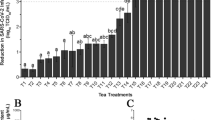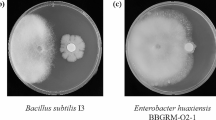Abstract
Antiviral assays of chemically and biologically synthesized silver nanoparticles were made against BmNPV (Bombyx mori Nuclear Polyhedrosis Virus). Reduction of silver ions by sodium citrate and Spirulina platensis led to the formation of spherical silver nanoparticles of 40–60 and 7–16 nm size. Single cell protein (Spirulina platensis)-synthesized silver nanoparticles showed the strongest antiviral activity. Immunological studies made on the silkworm Bombyx mori disclosed that a significant increase in the total hemocyte count and differential hemocyte count due to S. platensis-synthesized silver nanoparticles supplementation. Improvement in the defense mechanism was noticed from the strengthened peritrophic membrane of the digestive tract and the increased total protein. Overall, the results presented illustrate that single cell protein-synthesized silver nanoparticles supplementation is effective in controlling viral-borne diseases of the silkworm.












Similar content being viewed by others
References
Aizawa K (1963) The nature of infections caused by nuclear polyhedrosis viruses. In: Steinhaus EA (ed) Insect pathology. Academic press, New York
Arakawa T, Sugiyama M (2002) Promotion of nucleopolyhedrovirus infection in larvae of the silkworm, Bombyx mori (Lepidoptera: Bombycidae) by an antibiotic, nikkomycin. Appl Entomol Zool 37:393–397
Arnold JW (1979) Controversies about haemocyte types in insects. In: Gupta A (ed) Insect haemocytes. Cambridge University Press, Cambridge, pp 231–258
Attathom T, Sinchaisri N (1987) Nuclear polyhedrosis virus isolated from Bombyx mori in Thailand. Sericologia 27:287–295
Ayehunie S, Belay A, Hu Y, Baba T, Ruprecht R (1996) Inhibition of HIV-1 replication by an aqueous extract of Spirulina platensis (Arthrospira platensis). In: 7th IAAA conference, Knysna, South Africa, 17 April
Balavenkatasubbaiah M, Nataraju B, Thiagarajan V, Datta RK (2001) Haemocyte counts in different breeds of silkworm Bombyx mori L and their changes during the progressive infection of BmNPV. Indian J Seric 40:158–162
Basha KS, Govindaraju K, Manikandan R, Ahn JS, Bae EY, Singaravelu G (2010) Phytochemical mediated gold nanoparticles and their PTP 1B inhibitory activity. Colloids Surf B Biointerfaces 75(2):405–409
Bergold GH (1963) The nature of nuclear polyhedrosis viruses. In: Steinhaus EA (ed) Insect pathology. Academic press, New York
Bhattacharya A, Medda AK (1981) Effect of cyanocobalamin and cobalt chloride on the lipid content of silkgland of Bombyx mori L. race nistari. Sci Cult 7:140–141
Bonnemann H, Richards R (2001) Nanoscopic metal particles-synthetic methods and potential applications. Eur J Inorg Chem 10:2455–2480
Cantwell GE (1973) Methods for determining the level of Nosema infection in honeybees. In: Cantwell GE (ed) Insect diseases, vol 2. Marcel Deker, Inc., New York, pp 539–542
De Jong WH, Hagens WI, Krystek P, Burger MC, Sips AJAM, Geertsma RE (2008) Particle size dependent organ distribution of gold nanoparticles after intravenous administration. Biomaterials 29:1912–1919
Diehl-Jones WL, Mandato CA, Whent G, Roger GH, Downer G (1996) Monoaminergic regulation of haemocyte activity. J Insect Physiol 42:13–19
Dunn PE (1986) Biochemical aspects of insect immunology. Ann Rev Entomol 31:321–339
Elechiguerra JL, Burt JL, Morones RJ, Camacho A, Gao X, Lara HH, Yacaman MJ (2005) Interaction of silver nanoparticles with HIV-1. J Nanobiotechnol 3:1–10
Govindan R, Narayanaswamy TK, Devaiah MC (1998) Principles of silkworm pathology. Seri Scientific Publication, Bangalore, pp 64–65
Govindaraju K, Khaleel Basha S, Ganesh Kumar V, Singaravelu G (2008) Silver, gold and bimetallic nanoparticles production using single cell protein (Spirulina platensis) Geitler. J Mater Sci 43:5115–5122
Govindaraju K, Kiruthiga V, Ganesh Kumar V, Singaravelu G (2009) Extracellular synthesis of silver nanoparticles by a marine alga, Sargassum wightii Grevilli and their antibacterial effects. J Nanosci Nanotechnol 9:5497–5501
Hopkins TL, Harper MS (2001) Lepidopteron peritrophic membranes and effects of dietary wheat germ agglutinin on their formation and structure. Arch Insect Biochem Physiol 47:100–109
Hughes KM (1957) An annotated list and bibliography of insects reported to have virus diseases. Hilgardia 26:597–629
Jain PK, El-Sayed IH, El-Sayed MA (2007) Au nanoparticles target cancer. Nanotoday 2:18–29
Jones JC (1979) Pathways and pitfalls in the classification and study of insect haemocytes. In: Gupta AP (ed) Insects haemocyte development forms, functions and techniques. Cambridge University Press, Cambridge, pp 279–300
Kamat PV, Flumiani M, Hartland GV (1998) Picosecond dynamics of silver nano clusters light induced fragmentation and photojection of electrons. J Phys Chem B 102:3123–3128
Kawarabata T, Matsumoto K (1973) Isolation and structure of a nuclear polyhedrosis virus from polyhedra of the silkworm, B. mori. Appl Ent Zool 8:227–233
Krishnaswami S (1978) New technology of silk rearing. Bulletin no. 2. C.S.R. & T.I, Mysore, India
Kumar V, Yadav SK (2009) Plant mediated synthesis of silver and gold nanoparticles and their applications. J Chem Technol Biotechnol 84:151–157
Laemmli UK (1970) Cleavage of structural proteins during the assembly of the head of bacteriophage T4. Nature 227:680–685
Lian LY (1991) Silkworm diseases. FAO Agric Serv Bull 73:1
Lowry OH, Rosebrough NJ, Fara AL, Randall RJ (1951) Protein measurement with the folin phenol reagent. J Biol Chem 193:265–275
Mandal S, Phadtare S, Sastry M (2005) Interfacing biology with nanoparticles. Curr Appl Phy 5:118–127
Mandal D, Bolander ME, Mukhopadhyay D, Sarkar G, Mukherjee P (2006) The use of microorganisms for the formation of metal nanoparticles and their application. Appl Microbial Biotechnol 69:485–492
Martignini ME, Langston RL (1960) Supplement to an annotated list and bibliography of insects. Hilgardia 30:1–40
Masui H, Matsubara P (1983) Influence of cobalt and nickel in diet on larval development of the silkworm, Bombyx mori under aseptic conditions. J Seric Sci Japan 52:425–431
Mirkin CA, Letsinger RL, Mucic RC, Storhof JJ (1996) A DNA-based method for rationally assembling nanoparticles into macroscopic materials. Nature 382:607–609
Miyuki Y, Kiko I (2001) Bombyx mori L prohaemocyte division and differentiation in individual micro cultures. J Insect Physiol 47:325–331
Nagaraju J (2002) Application of genetic principles for improving silk production. Curr Sci 83:409–414
Nittono Y (1960) Studies on the blood cells in the silkworm, Bombyx mori L. Bull Seric Expt Stn 16:261–266
Padki PR (1991) Some aspects of physiology of the eri silkworm Philosomia ricini. PhD Thesis, Karnataka University, India
Pantin CRA (1948) Microscopical technique for zoologists. Cambridge University Press, London
Park SA, Taton TA, Mirkin CA (2002) Array-based electrical detection of DNA using nanoparticle probe. Science 295:1503–1506
Rai M, Yadav A, Gade A (2009) Silver nanoparticles as a new generation of antimicrobials. Biotechnol Adv 27:76–83
Ratnasen AshwathSK, Datta RK (2001) Inheritance of resistance to nuclear polyhedrosis virus in silkworm, Bombyx mori. Int J Indust Entomol 3:187–190
Rembaum A, Dreyer WJ (1980) Immunomicrospheres: reagent for cell labeling and separation. Science 208:364–368
Richards AG, Richards AP (1977) The peritrophic membranes of insects. Ann Rev Entomol 22:219–240
Sandhu KK, McIntosh CM, Simard JM, Smith SW, Rotello VM (2002) Gold nanoparticle-mediated transfection of mammalian cells. Bioconjug Chem B 13:3–6
Sondi I, Salopek-Sondi B (2004) Silver nanoparticles as antimicrobial agent: a case study on E. coli as a model for Gram negative bacteria. J Colloid Interface Sci 275:177–182
Srinivasa G, Sarangi RN, Geetha GS, Geethadevi RG, Vijayaprakash NB (2001) Cropping patterns and income levels of sericulturists in Mandya District, Karnataka—a comparative study. Indian J Seric 40:119–126
Vago C, Aizawa K, Ignoffo C, Martignoni ME, Tarasevitch L, Tinsley TW (1974) Present status of the nomenclature and classification of invertebrate viruses. J Invertebr Pathol 23:133–134
Wang P, Granados RR (2001) Molecular structure of the peritrophic membrane (PM) identification of potential PM target sites for insect control. Arch Insect Biochem Physiol 47:110–118
Acknowledgments
The authors profusely thank the Department of Science and Technology (DST Nanomission), New Delhi, Government of India for the financial assistance, and HR-TEM assistance of SAIF, IIT, Chennai. The authors also thank Prof. A.Jothi Murugan, Vice-chancellor, and Prof. B.Krihnamurthy, Registrar, Thiruvalluvar University, Vellore for their support and encouragements.
Author information
Authors and Affiliations
Corresponding author
Rights and permissions
About this article
Cite this article
Govindaraju, K., Tamilselvan, S., Kiruthiga, V. et al. Silvernanotherapy on the viral borne disease of silkworm Bombyx mori L.. J Nanopart Res 13, 6377–6388 (2011). https://doi.org/10.1007/s11051-011-0390-3
Received:
Accepted:
Published:
Issue Date:
DOI: https://doi.org/10.1007/s11051-011-0390-3




